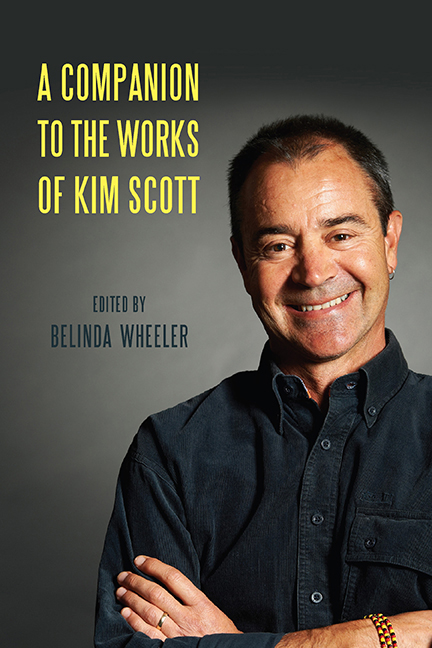Book contents
- Frontmatter
- Contents
- Foreword
- Acknowledgments
- Note on Orthography
- Chronology of Key Writings
- Introduction
- 1 Kim Scott’s Publishing History in Three Contexts: Australian Aboriginal, National, and International
- 2 Kim Scott’s True Country as Aboriginal Bildungsroman
- 3 The Land Holds All Things: Kim Scott’s Benang—A Guide to Postcolonial Spatiality
- 4 Kim Scott’s Kayang and Me: Noongar Identity and Evidence of Connection to Country
- 5 “Wreck/Con/Silly/Nation”: Mimicry, Strategic Essentialism, and the “Friendly Frontier” in Kim Scott’s That Deadman Dance
- 6 The International Reception of Kim Scott’s Works: A Case Study Featuring Benang
- 7 Traumatic Landscapes: Inscribing Spectrality and Identity in Kim Scott’s “A Refreshing Sleep,” “Capture,” and “An Intimate Act”
- 8 Spatial Poetics and the Uses of Ekphrasis in Kim Scott’s “Into the Light” and Other Stories
- 9 The Poetry of Kim Scott
- 10 The Wirlomin Project and Kim Scott: Empowering Regional Narratives in a Globalized World of Literature
- 11 Kim Scott as Boundary Rider: Exploring Possibilities and New Frontiers in Aboriginal Health
- 12 An Interview with Kim Scott
- Notes on the Contributors
- Index
7 - Traumatic Landscapes: Inscribing Spectrality and Identity in Kim Scott’s “A Refreshing Sleep,” “Capture,” and “An Intimate Act”
Published online by Cambridge University Press: 08 May 2021
- Frontmatter
- Contents
- Foreword
- Acknowledgments
- Note on Orthography
- Chronology of Key Writings
- Introduction
- 1 Kim Scott’s Publishing History in Three Contexts: Australian Aboriginal, National, and International
- 2 Kim Scott’s True Country as Aboriginal Bildungsroman
- 3 The Land Holds All Things: Kim Scott’s Benang—A Guide to Postcolonial Spatiality
- 4 Kim Scott’s Kayang and Me: Noongar Identity and Evidence of Connection to Country
- 5 “Wreck/Con/Silly/Nation”: Mimicry, Strategic Essentialism, and the “Friendly Frontier” in Kim Scott’s That Deadman Dance
- 6 The International Reception of Kim Scott’s Works: A Case Study Featuring Benang
- 7 Traumatic Landscapes: Inscribing Spectrality and Identity in Kim Scott’s “A Refreshing Sleep,” “Capture,” and “An Intimate Act”
- 8 Spatial Poetics and the Uses of Ekphrasis in Kim Scott’s “Into the Light” and Other Stories
- 9 The Poetry of Kim Scott
- 10 The Wirlomin Project and Kim Scott: Empowering Regional Narratives in a Globalized World of Literature
- 11 Kim Scott as Boundary Rider: Exploring Possibilities and New Frontiers in Aboriginal Health
- 12 An Interview with Kim Scott
- Notes on the Contributors
- Index
Summary
THE FICTIONAL LANDSCAPES in Kim Scott's short stories are fraught topographies, figuratively embedded with layers of historical and ancestral trauma. This chapter is an exploration of three short stories by this author: “A Refreshing Sleep” (2009), “Capture” (2002), and “An Intimate Act” (1993), which have remained largely unexamined in an academic context, particularly in relation to landscape, identity, and trauma. Explored as a trio here, these short stories depict various Australian topographies including suburbia, bush, and desert. Regardless of their variety, however, the landscapes in the examined narratives are haunted by the past, as evinced in motifs of loss, trauma, and dislocation. Scott's accounts in his body of work, as the Melbourne academic Alison Ravenscroft affirms, are tales that reflect Australia's shameful treatment of Indigenous subjects, of “unspeakable violations of women and children, and so on. These are stories that should bring the country down” (“Ravenscroft Replies,” 4). In utilizing the lens of trauma theory, such as the work of Maria Tumarkin and others, I argue here that these shameful stories with their attendant haunted landscapes that appear in Scott's short fiction are explorations of historical ancestral trauma, which pervades and disrupts contemporary Indigenous identity. The trauma theorist Cathy Caruth contextualizes trauma in relation to history and subjectivity: “the traumatized, we might say, carry an impossible history within them, or they become themselves the symptom of a history that they cannot entirely possess” (5). As a symptom of history, this trauma is often exhibited in Scott's narratives in the form of haunting, anxiety, and dislocation, as well as psychological damage. Trauma theory, therefore, becomes a useful lens with which to read these narratives because it “links events of extreme violence, structures of subjective and collective experience, with discursive and aesthetic forms” (Rothberg, xiii). In the words of Buelens, Durrant, and Eaglestone, trauma theory, therefore, is “an attempt to trace the inexhaustible shapes both of human suffering and … responses to that suffering” (7). This historical Indigenous trauma, passed down intergenerationally, is striking in Scott's three short narratives, particularly in the way it is projected onto the landscape and problematically incorporated into Indigenous identity, often as negation, absence, or loss.
- Type
- Chapter
- Information
- A Companion to the Works of Kim Scott , pp. 88 - 100Publisher: Boydell & BrewerPrint publication year: 2016



